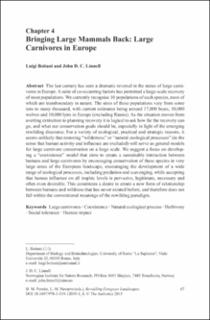| dc.description.abstract | The last century has seen a dramatic reversal in the status of large carnivores in Europe. A suite of co-occurring factors has permitted a large-scale recovery of most populations. We currently recognise 10 populations of each species, most of which are transboundary in nature. The sizes of these populations vary from some tens to many thousand, with current estimates being around 17,000 bears, 10,000 wolves and 10,000 lynx in Europe (excluding Russia). As the situation moves from averting extinction to planning recovery it is logical to ask how far the recovery can go, and what our conservation goals should be, especially in light of the emerging rewilding discourse. For a variety of ecological, practical and strategic reasons, it seems unlikely that restoring “wilderness” or “natural ecological processes” (in the sense that human activity and influence are excluded) will serve as general models for large carnivore conservation on a large scale. We suggest a focus on developing a “coexistence” model that aims to create a sustainable interaction between humans and large carnivores by encouraging conservation of these species in very large areas of the European landscape, encouraging the development of a wide range of ecological processes, including predation and scavenging, while accepting that human influence on all trophic levels is pervasive, legitimate, necessary and often even desirable. This constitutes a desire to create a new form of relationship between humans and wildness that has never existed before, and therefore does not fall within the conventional meanings of the rewilding paradigm. Large carnivores · Coexistence · Natural ecological process · Herbivory · Social tolerance · Human impact | en_US |

